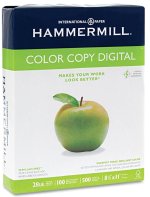Just a side note that might help when discussing brightness/whiteness with suppliers.
For most printers and print buyers, the terms brightness and whiteness are interchangeable. However, when describing the characteristics of paper there are some important differences between the two terms.
Brightness refers to the percent reflectance of blue light, as measured at a wavelength at, or about, 457nm. The choice of that wavelength is based on the sensitivity of the human eye to blue and yellow light. Brightness was originally a test in paper manufacturing to measure the effectiveness of the bleaching process in removing yellowness from pulp. When paper is bleached, the spectral reflectance curve increases the most in the blue and violet range, at about the 457nm point. This has also made the measurement of brightness well suited for measuring the aging of paper because paper yellows with age. Most white papers are in the 60 to 90% brightness range.
"Brightness" is also not a measurement that printers or buyers can measure themselves and even though variation is part of every manufacturing process, there are no defined tolerances for paper brightness.
Whiteness, on the other hand, refers to the extent to which paper reflects equally the light of all wavelengths throughout the visible spectrum. A truly white sheet of paper will not absorb one wavelength of light energy more than another. For example, if a sheet of paper is placed under a full spectrum light, most of that light will be reflected back equally and the paper will appear white. However, if some of the wavelengths of light energy are absorbed, the color of the paper will shift to the light which was not absorbed, but was instead reflected back to the viewer. That is why a red sheet of paper appears red in white light because it absorbs all the other colors and reflects only the red.
The color of paper is typically identified using adjectives like "cream","natural", "white", etc. rather than objective definitions such as the CIEL*a*b* coordinates that printers use. But CIEL*a*b* values can be used to compare the color of different papers. Again, there are no specifications or tolerances provided by mills as to the consistency of a specific paper color.
Lastly, there are no specifications or tolerances or even notification of optical brightener agent (OBAs) content. This has become a major issue as the mills have mostly switched from clay fillers to calcium carbonate. Papers with optical brighteners are impossible to visually match between printing technologies which can cause severe disconnects between proof and presswork as well as greater color shifting as presswork and/or proof are viewed under different lighting conditions.












